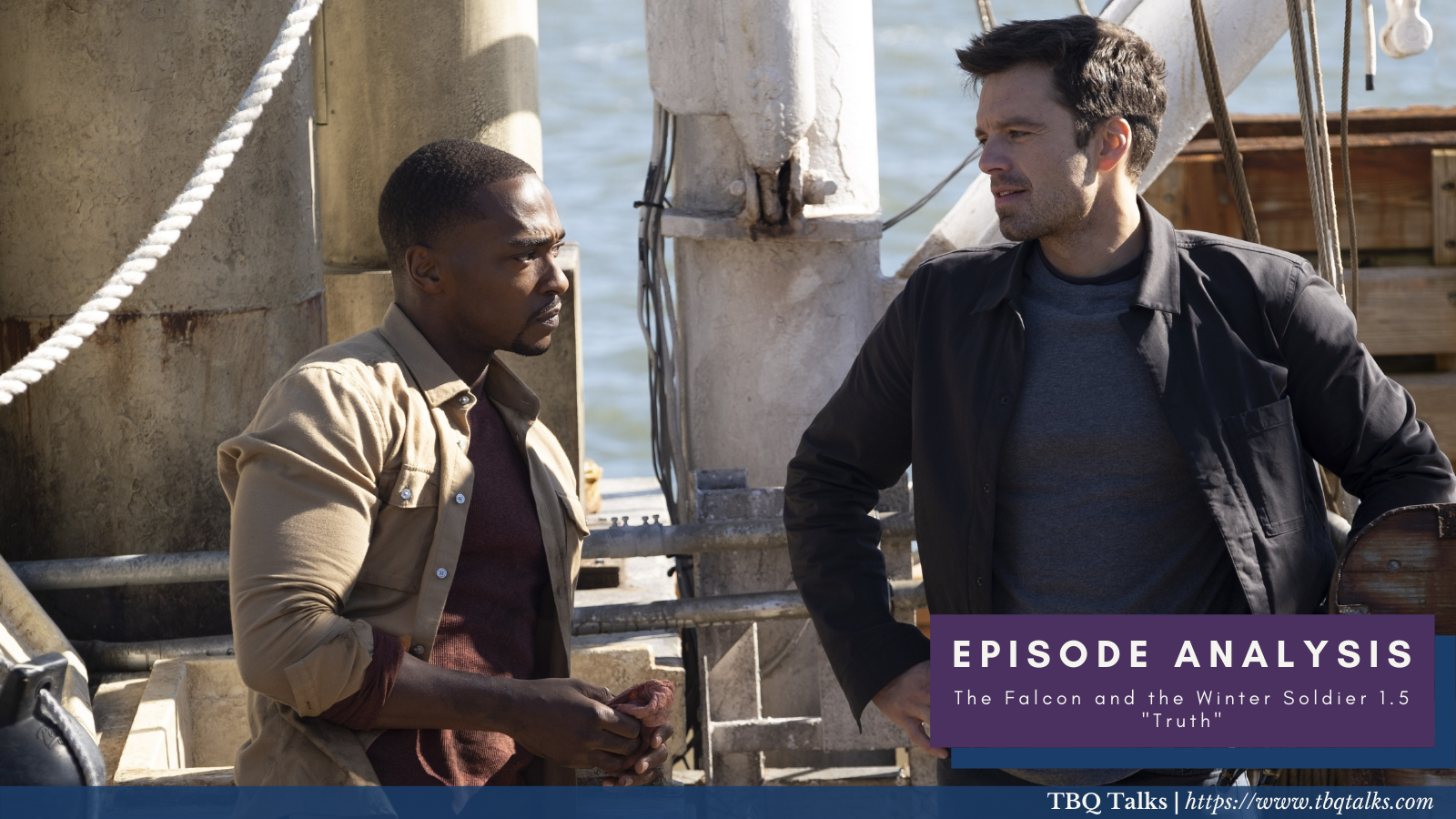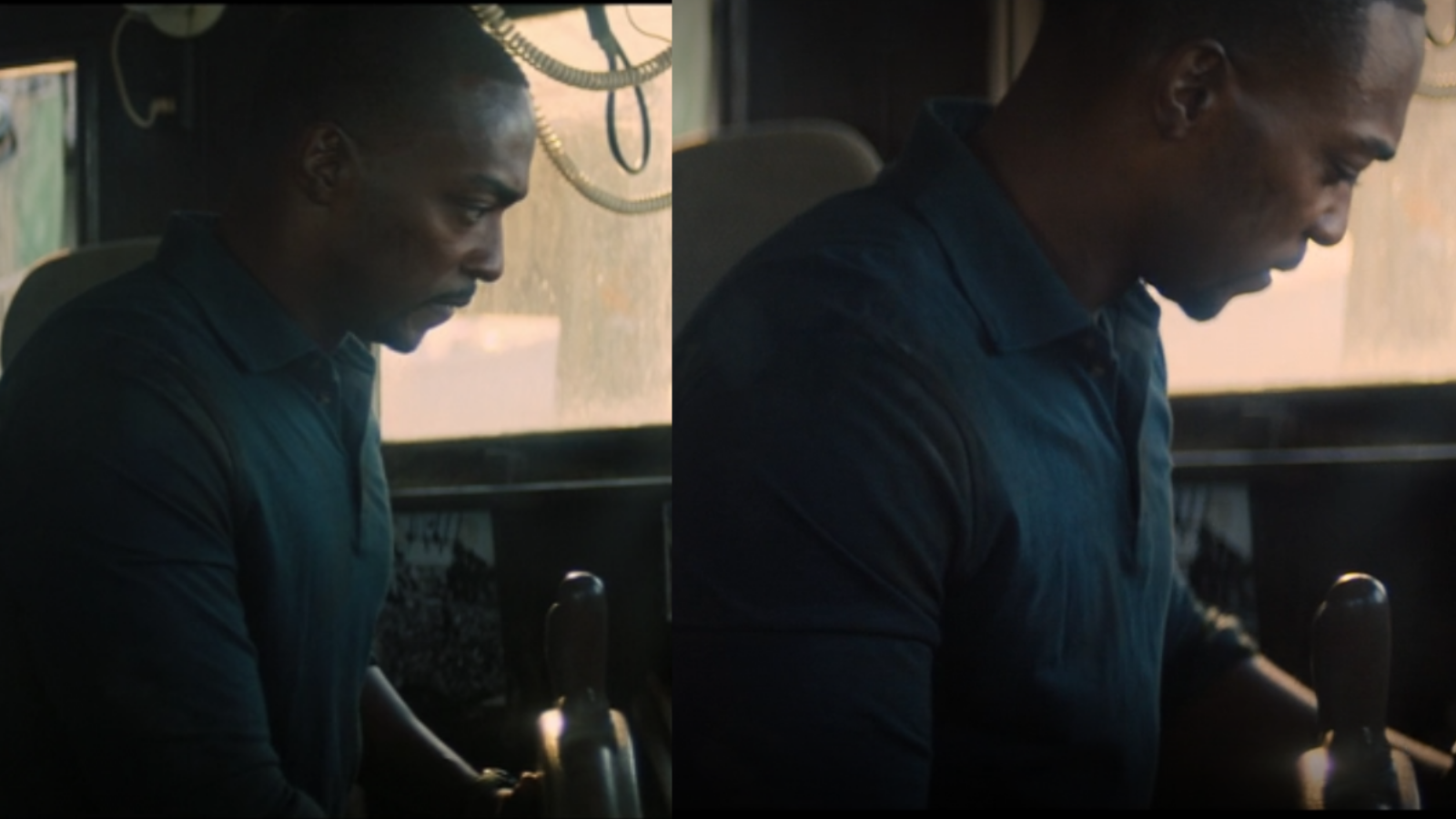The Falcon and the Winter Soldier Episode 5 Analysis: "Truth"
How Louisiana History and the Show's Costuming Shape Our Understanding of Why Sam Wilson Becomes Captain America.

Spoilers ahead for The Falcon and the Winter Soldier Episode 5.
Intro
The show ruined my stupid titling convention by giving this episode a single word name. You win this time, Disney+, THIS TIME!
Ahem. Anyway...
I can't say enough about how much I loved the Sam Wilson Show this week. And that's really what it was. The Flag Smashers storyline was superfluous and frankly always has been. At best it's the vehicle by which we get the Sam Wilson Show. At worst it was a casualty of serious post-Covid rewrites. (Which I'll get into with next week's ep if it becomes relevant.)
Obviously the entire show, in spite of the name The Falcon and the Winter Soldier, has been the Sam Wilson Show. It's been about Sam becoming Captain America: What does that mean to him? Does he want the job? Does he think he deserves it? What does it mean to us if he does it?
This episode solidifies that decision. And obviously it culminates in Sam opening the case from Wakanda in preparation for putting his new suit on, but the show is telling us about Sam's reasoning and motivation the whole time, and not just via speeches from various characters.
So let's talk about how history and the costuming department help explain to us why Sam becomes Cap.
The Boat Isn't Just A Boat
Sam and Sarah's family being from Delacroix Louisiana tells us a great deal about their family history and them as characters. We've discussed this before but let's get into more details, particularly since it ties in to the importance and meaning of the boat.
What the show tells us outright is that the Wilson family has been in Delacroix for generations and has operated the fishing company for generations. Great. We know from the show that this is a family business and thus at the very least symbolizes the memories of their parents and grandparents to Sam and Sarah.
But that would be any family fishing business. A Delacroix business operated by a Black family for generations means something much more.
Delacroix is a part of Louisiana about 45 min away from New Orleans. It was predominantly occupied by the Spanish. Louisiana was taken over by the Spanish from the French as well but in most places, like New Orleans, the French influence was too hard to shake.
Delacroix, being more isolated due to its island location, instead kept its Spanish heritage. Spanish music and language is much stronger there than it is in New Orleans, for example.
Remember how Sam called his aunt his Tití? The show is telling us about that influence on Sam's life without lampshading it.
Due to its remote nature, Delacroix started out as a place primarily for trappers and fishers. With time, however, it went the way of most places in Louisiana and gave rise to plantations.
The Wilson family has been in the area for generations. Though there were free people of color in Louisiana those families did not start out free. The Wilson family being in Louisiana for generations means that the Wilson family was enslaved on those plantations.
This also means that, when we are told the fishing company has been in the family for generations, the fishing company is what they made for themselves when they were freed. The boat isn't just a business, it isn't just a family memory, it's the symbol of the thing Sam and Sarah's ancestors first laid claim to as something in this country that was theirs.
The boat being worn down and seemingly unusable due to everything that has happened over the years is the same as what has happened to Sam and his family: there has been disaster, death, tragedy. It's so worn down it can't possibly find a new life. The debate for Sam and Sarah stops being if they should sell it and becomes should they even do anything with it at all.
But what happens next? Sam reaches out to the community.
The other thing about Delacroix is that it has a long history of people coming together after tragedy. Its location means that it gets hit harder by floods and hurricanes than other places in Louisiana. It has been destroyed over and over again and reborn because the people who live there care enough about the place and each other to help when times are hard.
The boat is fixed because of community. Sam and Sarah's place in the world is improved and aimed towards the future because of their connections to the people who have lived through the same experiences that they have.
Sam himself can look back at the history of Captain America, at the tragedy and torment which has been the price of that shield, and at the horrors of what America has done and continues to do to Black people, and come to the conclusion that it's not something to be thrown away. It's something that can be worked on, can be given value by himself and his connections to those who understand all that pain, and by the desire to keep doing the work no matter how hard it is.
Sam says to Sarah: "What would be the point of all the pain and sacrifice if I wasn't willing to stand up and keep fighting?"
What is that sentiment if not a man who has been bloodied and beaten, getting up with the last tiny bit of strength inside him, staring down the challenges in front of him and replying "I can do this all day"?
The Clothes Aren't Just Clothes
We're told about Sam's journey to becoming Captain America through clothing and color in this episode as well. So much so that it's possible to catch an editor trying to sneakily use the wrong shot in one of the scenes. But we'll get to that.
As always with costume and color stories in this show, we can start with John and his wife as an easy entry. During the courtroom scene Olivia is wearing a shirt with blue horizontal stripes on it. It evokes the stripes on John's Captain America uniform. It's a visual cue of Olivia's role here: the wife in the public eye standing by her man who was caught doing something wrong.
But then we start looking at the overall themes as we realize there's two messages going on here.
Throughout the episode the color blue represents the weight and impact of the concept of Captain America. Olivia wears blue: her life and marriage have been affected. Bucky sometimes wears shades of blue: he's in Cap's orbit, trying to figure out who he is in relation to it all. Whenever there is a scene of Sam debating taking on the mantle, he's wearing blue.
But then we have blue with stripes.
Blue shirts with thin stripes mean the legacy of Captain America is pain. Oliva is in blue with stripes. Isaiah is in blue with stripes. Lemar's father is in blue with stripes. Horizontal stripes across their chests, representing not just John's outfit but a visual cue about how something in their lives was blocked because of Cap. There is no upward progress for them, only a painful stop.
Isaiah says it himself: "Those stars and stripes don’t mean nothin’ good to me."
(Emphasis mine)
So if blue means the impact of Captain America, which is another way of saying the ripples of Captain America's past, what does red mean?
Captain America's future.
Sam's wearing blue when he talks to his nephews about taking one last trip out with the boat before it's gone: a moment about how the weight of the past can't be overcome and it's best to recognize that and give up. He then turns to Sarah who tells him they aren't selling the boat.
Sarah? Is wearing red.
When Sam goes from giving up on the boat to working with the community to fix it he switches into a red shirt. During his training montage he starts out in blue and as he improves his clothes become more and more red.
Even Sam's nephews get in on it, first wearing blues to represent how the legacy and impact of Captain America aren't always necessarily a bad thing, but later wearing red to reinforce how Sam's decision will impact the future. One of Sam's nephews even directly contrasts Isaiah's statement: he wears red while touching the star on Sam's shield. It means something to him.
And it is not putting down Isaiah's words. Isaiah's history is important, it's meant to have an impact. But for Sam it is not meant to be where he stops. The show reinforces this. While Sam hears Isaiah's history he sits on a couch with red curtains surrounding the window behind him. Yes, it's important for Sam to start by hearing Isaiah and taking his story with him, but his future means looking away from where Isaiah is now and focusing somewhere else.
(Also who is playing basketball outside that window? Eli Bradley, wearing a red shirt.)
Moreover when Isaiah says "They will never let a Black man be Captain America. And even if they did, no self-respecting Black man would ever wanna be." Sam turns his head to the side and we see cuts on his cheek.
What shape are those cuts in? Red stripes. Sam's future is going to be a painful one, but it's still the path he needs to take.
As I said the color story was so strong in this episode that you can catch an editor pulling a fast one. During the montage of Sam and Bucky fixing the boat Sam is in a blue shirt halfway through. This makes no sense both for the symbolism and for the story: the montage happens during the course of one day, why would Sam change out of his red shirt to blue and then back into the same red shirt again?
He didn't. The editor slipped in shots of Sam in the boat from episode one and probably hoped/assumed nobody would notice.

My guess is that this was due to footage limitations thanks to Covid where they had to use whatever was available. Sadly for them the costuming department's game was too good for this to easily slip past. Sorry, editor! Points for effort at least?
And of course we get the final color conclusion: to take the final step to becoming Captain America, Sam pushes a red button (Cap's future) which then turns blue (the weight of the role).
You gotta love it.
Lagniappe
- The Hollywood Reporter has a great article about race in the show.
- As you might imagine, I adored this twitter thread about why John's costume makes us dislike him.
- I like how John's story is showing how he's been screwed by the military as well. There are plenty of real world vets who have been traumatized by what they were asked to do in service who then come home and aren't given the help they need. What John needs most is psychiatric care and treatment. By stripping him of not only his title but his benefits, he's left with no way of getting that. Not unless the post snap United States implemented universal healthcare.
- AHAHAHAHA I know. I'm funny sometimes.
- Kudos to Marvel for keeping Julia Louis-Dreyfus well under wraps. It was known in the spoiler community that there would be a cameo in this ep. The most that was known was that it was a woman and a character not yet seen in the MCU. But not a soul guessed either JLD or her character. That's impressive secret keeping, especially when you don't need to be up on spoilers to guess that they're not bringing in a name like hers for a one off in a TV show. (movie spoilers at the link. I won't say which one since that in and of itself is a spoiler.)
- I loved the changes to Bucky's fight choreography in this ep. When he was fighting the Flag Smashers he was all about efficiency since they were not on his skill level. John, on the other hand, has training, the serum, and the shield. Bucky's fighting was therefore faster, harder, and involved him leading with his vibrainium arm more often than not.
- "You got your sleeve back" - HA. Torres is me, I am Torres.
- Bucky being told "don't call us, we'll call you" by Wakanda is a fair "find out" for him fucking around by taking Zemo out of jail. Though I have to imagine Ayo's initial response to Bucky asking for another favor was "Have you lost your god damn MIND?" This was probably not so much a favor to Bucky as it was to Sam.
- Me being me, I of course pictured Bucky after the fact having to squat down and awkwardly scoop up all those dropped bullets before he walked away.
- Let us admire that Sam was doing all that training in a place which regularly gets 100% humidity. Respect.
- Also note how Sam's training is entirely himself: he's got no fancy equipment. Just trees, running, and pushups. It's entirely his hard work and the effort he puts in.
- More and more I feel like we're going to find out that Sharon's role in this series was to give us glimpses of her life to set up whatever she's doing in some future Disney+ series. Whether or not she's the Power Broker it doesn't feel like there's enough room for next week's episode to give the climax to her story on top of Sam's, the Flag Smashers, John, and even a tiny bit of closure to Bucky. I feel like we're heading towards seeing Sharon in next week's mid credit sequence which ends with "Sharon Carter (and probably Zemo) will return in [NEW SHOW NAME]." Especially because...
- I don't buy that the Doras would think it was smart to drop Zemo off at The Raft. May as well hop universes and drop him off at Arkham if you want to leave him somewhere with a revolving door. That too clearly smacks of being motivated by something outside of characterization.
- Nobody in the Flag Smashers got on Karli's case for being the one solely responsible for the circumstances which led to the brutal death of their friend and all their fellow refugees being kicked out again?
- Credit where due, Charles Pulliam-Moore is right in that Sam often comes off as far too out of the loop about race in America. I think this is what happens when you have a main character acting as an audience stand in who isn't ideal for the job. The problem is that if Bucky was used as the lens by which these history lessons happened, it would center Bucky in the story more than he should be (no offense, Bucky). Which probably points to how the ultimate problem is that the show is aimed at white people like myself more than it is for a Black audience who already knows what being Black in America is like.
- On the topic of those lessons, Isaiah is referencing the Tuskegee Airmen when he talks about red tails and the 332.
- Continuing the series theme of direct callbacks to things Steve did, Isaiah disobeying orders to rescue the other men is a direct correlation to when Steve did the exact same thing in WWII. But when Steve did it not only was he hailed as a hero, he was specifically cheered as Captain America. (Granted it was Bucky who led that cheer but still.)
- Also it's worth noting that Steve did offer to turn himself in for disciplinary action and he was told it wouldn't be necessary. So even more of Steve's white privilege at play.
- Anthony Mackie was a king of showing a lot while saying very little. In addition to the epic looks he gave Bucky there was also the layers of gut-churning fear coupled with psyching himself up determination when he got ready to put the suit on.
- Though if we're talking about epic looks we'd be remiss not to also tip our hats to Olivia staring daggers over Val's shoulder.
- Finally, shout out to the "You up for a little tough love?" scene. It's genuinely nice to see an example of healthy, every day respect for people's boundaries in conversation. You can tell Sam used to be a very good counselor.
And that's all for now. See you next week when we find out if the show sticks the dismount or makes me flip double birds faster than WandaVision did.
Outro
Want to help support the site and get access to the Bonus Content? Sign up for a paid subscription or donate via Ko-Fi. Thank you!

